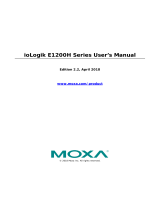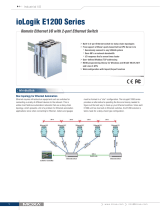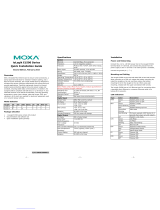
Peer-to-Peer Settings (1-50)....................................................................................................... 3-20
Sample Peer-to-Peer Configuration .............................................................................................. 3-21
Server Settings: ................................................................................................................ 3-21
Client Settings: .................................................................................................................. 3-21
DO Safe Mode Settings .............................................................................................................. 3-22
AO Safe Mode Settings ............................................................................................................... 3-22
SNMP .............................................................................................................................................. 3-22
SNMP Trap ............................................................................................................................... 3-22
Standard Trap ................................................................................................................... 3-22
Private Trap ...................................................................................................................... 3-23
Using SNMP .............................................................................................................................. 3-23
SNMP Agent ...................................................................................................................... 3-23
SNMP Trap Settings ............................................................................................................ 3-23
SNMP Trap Server .............................................................................................................. 3-23
SNMP Trap ........................................................................................................................ 3-24
Specific ID ........................................................................................................................ 3-24
Digital Input / Counter Trap Settings .................................................................................... 3-24
Digital Output / Pulse Output Trap Settings ........................................................................... 3-24
Analog Input Trap Settings .................................................................................................. 3-25
RTD Input Trap Settings ..................................................................................................... 3-26
TC Input Trap Settings ....................................................................................................... 3-26
Change Password ............................................................................................................................. 3-27
Load Factory Defaults ........................................................................................................................ 3-28
Save/Restart .................................................................................................................................... 3-28
4. Using ioSearch™ ................................................................................................................................ 4-1
Introduction to ioSearch™ ................................................................................................................... 4-2
ioSearch™ Main Screen ....................................................................................................................... 4-2
Main Screen Overview .................................................................................................................. 4-2
ioSearch™ Setup ................................................................................................................................ 4-3
System ...................................................................................................................................... 4-3
Sort ........................................................................................................................................... 4-4
Quick Links ................................................................................................................................. 4-4
Main Function ..................................................................................................................................... 4-4
Locate ........................................................................................................................................ 4-5
Firmware Upgrade ....................................................................................................................... 4-5
Batch Upgrades on Multiple Devices of the Same Model ............................................................ 4-5
Unlock ....................................................................................................................................... 4-5
Import ....................................................................................................................................... 4-6
Export ........................................................................................................................................ 4-6
Change IP Address ...................................................................................................................... 4-7
Batch TCP/IP Configuration on Multiple Devices ............................................................................... 4-7
Restart System ........................................................................................................................... 4-8
Reset to Default .......................................................................................................................... 4-8
Mass Deployment (Import) ........................................................................................................... 4-9
Mass Deployment (Export) ........................................................................................................... 4-9
5. Active OPC Server ............................................................................................................................. 5-1
Introduction to Active OPC Server ......................................................................................................... 5-2
OLE for Process Control ................................................................................................................ 5-2
Active OPC Server—From Pull to Push ............................................................................................ 5-3
Features of Active OPC Server .............................................................................................................. 5-5
One Simple Click Creates Active Tags ............................................................................................ 5-5
Faster, More Accurate Data Collection than Traditional “Pull Technology” ............................................ 5-5
Dynamic IP Assignments for Cellular RTUs ...................................................................................... 5-6
Active OPC Server Setup ..................................................................................................................... 5-6
Installing Active OPC Server ......................................................................................................... 5-6
Main Screen Overview .................................................................................................................. 5-7
Menu Bar ................................................................................................................................... 5-7
A. Modbus/TCP Default Address Mappings ............................................................................................ A-1
E1210 Modbus Mapping ....................................................................................................................... A-2
0xxxx Read/Write Coils (Functions 1, 5, 15) ............................................................................ A-2
1xxxx Read Only Coils (Function 2) ........................................................................................ A-4
3xxxx Read Only Registers (Function 4) .................................................................................. A-4
E1211 Modbus Mapping ....................................................................................................................... A-5
0xxxx Read/Write Coils (Functions 1, 5, 15) ............................................................................ A-5
1xxxx Read Only Coils (Function 2) ........................................................................................ A-6
E1212 Modbus Mapping ....................................................................................................................... A-7
0xxxx Read/Write Coils (Functions 1, 5, 15) ............................................................................ A-7
1xxxx Read Only Coils (Function 2) ...................................................................................... A-10
3xxxx Read Only Registers (Function 4) ................................................................................ A-11
4xxxx Read/Write Registers (Functions 3, 6, 16) .................................................................... A-11
E1213 Modbus Mapping ..................................................................................................................... A-11






















